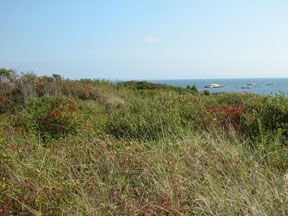What Are They?
For many of us, the summer would not be complete without at least one trip to the beach – that sandy, sometimes rocky area between Long Island Sound and land. Beaches and dunes are formed by water and wind currents leading to erosion and accretion. With Long Island forming a protective barrier, the Connecticut coast is not subject to the same intensity of water and wind currents as those coastal areas lying directly adjacent to the Atlantic Ocean. For this reason, dune systems are smaller and less well developed along our coastline than in other coastal states. Because of the variability in Connecticut's coastal geology and past geologic history (glaciation), one does not find the long stretches of beach characteristic of many Atlantic facing coastlines.
Vegetation
One of the most common and important plants of these dunes is American beach grass (Ammophila breviligulata). This grass has an extensive root system and can spread via underground stems or rhizomes. This root system acts as a natural erosion control device, helping to stabilize the shifting sands of the dunes and the leaves of the plant provide a barrier to wind blown sand particles causing them to be deposited. As the grass is buried by sand, new plant growth is stimulated. Other plants that may be found on the beaches, dunes or sand flats are seaside goldenrod, dusty miller, sea rocket, Virginia rose, beach plum, northern bayberry, and several state listed rare plants including prickly pear cactus (Opuntia humifusa)
Why They’re Important
Many birds, native plants, several reptiles and invertebrates depend on these areas for survival. Numerous birds use the beaches and dune system as nesting and feeding areas. Piping plovers and least terns are two state listed birds that nest along the shoreline. Another animal that has been observed along the Connecticut shoreline and tidal marshes is the diamondback terrapin, a small turtle (5-7 inch shell length) named for the diamond patterns on its top shell. This turtle lays eggs in the sand in the early summer.
Threats to the beaches, dunes and their inhabitants are numerous – ranging from habitat loss to invasive species. Disturbances include pedestrian, vehicular, and boat traffic, pets and feral animals.
Climate Change
Climate change is also impacting our beach-dune systems. Storm surge during storm events along with the potential for stronger storms and sea level rise are increasing the susceptibility of these systems to erosion. The current projection for sea level rise along the Connecticut coast is 20 inches by 2050. If beaches cannot move landward (transgress), areas may be inundated by sea level rise over time. There are a number of potential management options to help control erosion and maintain healthy habitats:
- Planting beach grass when needed after storms, minimizing trampling or cutting of beach grass, and minimizing trails through dunes will help maintain healthy ecosystems.
- Beach nourishment is a practice in which clean sand or sediment is added to beaches to combat loss of sand through erosion and widen a beach. This process was recently, successfully used at Hammonassett State Park. Living shorelines are another technique used to mitigate shoreline erosion.
- Living shorelines are a management practice that utilize as many natural elements as possible to dampen wave energy and encourage sediment deposition while maintaining the land-water interface. These natural elements may include coir fiber logs, shellfish reefs, low rock sills and reef balls. CT DEEP has information about living shorelines on their website along with several living shoreline projects. A three part workshop about living shorelines in Connecticut was held through AdaptCT and the powerpoints are available. Because the Connecticut shoreline is highly variable in terms of geology, topography, bathymetry and other physical characteristics, what works in one site may or may not work in another. Detailed, site specific coastal engineering studies are needed before embarking on a living shoreline project.
Details
For more detailed information download Coastal Beaches & Dunes (PDF).
Links
Long Island Sound Study, Long Island Sound Habitat Restoration Initiative


For Citation Purposes: Connecticut Sea Grant & University of Connecticut’s Center for Land Use Education and Research. (October 20, 2016). Beaches & Dunes. https://climate.uconn.edu/habitats-resources/coastal/beaches